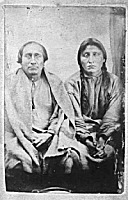This is the Dakota Pictures page
To see the photos of the Dakota in 1858 - 1863 please go to the following page
 The '+ 2' Shakopee and Medicine Bottle |
|
Some information came in from one of our members and I think it belongs on this page
|
Socially, the Dakota originally consisted of a large number of local groups or bands, and, although there was a certain tendency to encourage marriage outside the band, these divisions were not true gentes remembered blood relationship, according to Clark, being the only bar to marriage. Personal fitness and popularity determined chieftainship more than heredity, but where decent played any part it was usually from father to son. The tipi might belong to either parent and was obtained by that parent through some ancestor who had had its character revealed in a dream or who had captured it in war. The authority of the chief was imited by the band council, without whose approbation little or nothing could be accomplished. War parties were recruited by individuals who had acquired reputation as successful leaders, while the shamans formulated ceremonial dances and farewells for them. Polygamy Was common, the wives occupying different sides of the tipi. Remains of the dead were usually, though not invariably, placed on scaffolds. In 1904 the Dakota were distributed among the following agencies and school superintendencies: Cheyenne River (Miniconjou, Sans Arcs, and Two Kettle), 2,477; Crow Creek (Lower Yanktonai), 1,025; Ft Totten school (Sisseton, Wahpeton, and Pabaksa), 1,013; Riggs Institute (Santee), 279; Ft Peck (Yankton), 1,116; Lower Brutes (Lower Brgle), 470 Pine Ridge (Oglala), 6,690; Rosebud (Brulé, Waglukhe, Lower Brulé, Northern, Two Kettle, and Wazhazha), 4,977; Santee (Santee), 1,075; Sisseton (Sisseton and Wahpeton), 1,908; Standing Rock (Sihasapa, Hunkpapa, and Yanktonai), 3,514; Yankton (Yankton), 1,702 - by Allen Sheppard The names of the men who were hung or imprisoned in 1862 The names of the women imprisoned in Fort Snelling in 1862/3 The above 2 pages were from a site I made years ago for the Dakota Woman's March, I just amended them to fit in with this website. - GHD |